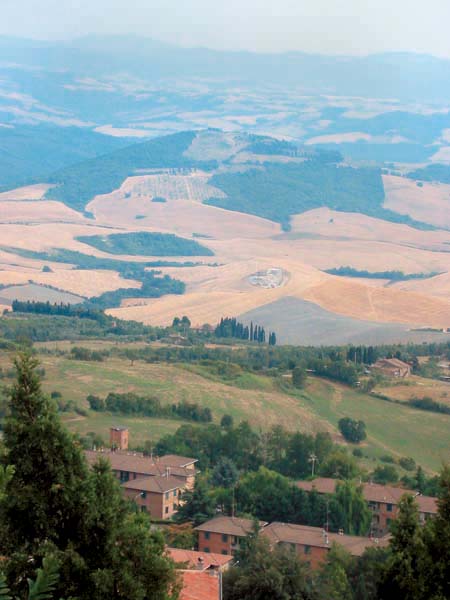
One afternoon in November 1634, 19-year-old Curzio Inghirami went fishing with his 13-year-old sister in the river behind their house. Their villa, called Scornello, stood on an isolated hill in the countryside south of Volterra, the highest and most remote of the ancient Etruscan cities. On their way home Curzio amused himself by rolling stones down the riverbank. One stone uncovered a “small blackish clod,” bound together with bitumen and wax. On breaking open the bundle, he found a scroll of linen rag paper marked with strange writing.
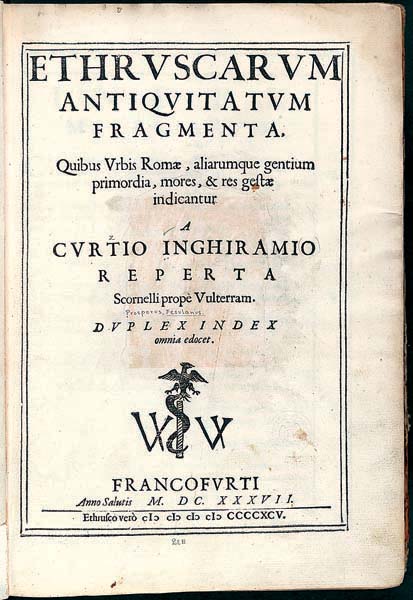
This scroll was wrapped around another scroll with Latin writing:
In the year of the prophesied King of the Jews 1624, one thousand five hundred ninety-first from his Crucifixion: A dog shall come who shall serve out his term of indenture faithfully for nine years, and more. The Wolf is the mother of the Lamb. The Lamb shall love the Dog. A Pig shall come forth from the horde of Pigs and shall devour the work of the Dog.
Beware, beware, beware!
Prospero of Fiesole, resident of this colony, Guardian of the Citadel, prophesied the year after Catilina’s death. You have discovered the treasure. Mark the spot, and go away.1
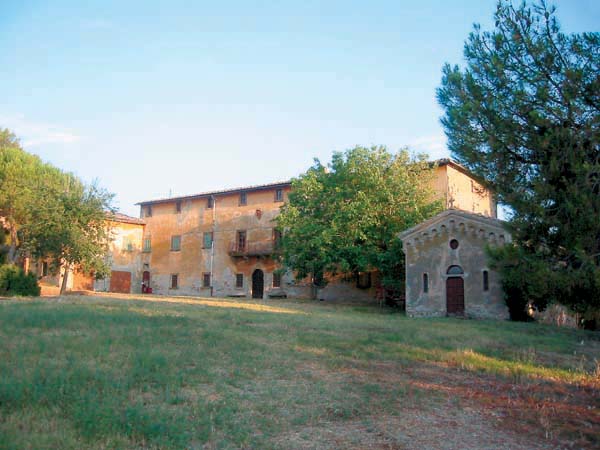
Some weeks later the Inghiramis’ tutor, Father Domenico Vadorini, came by Scornello to celebrate the Feast of Saint Lucy. When Curzio brought out the scrolls, Vadorini proposed that they mount an excavation of the site. After summoning Scornello’s tenant farmers, they soon cleared a well with a stone urn embedded in one of its crannies. The urn contained another bundle, similar to the one Curzio had found by the river, inscribed on the outside with what appeared to be Etruscan letters.
Curzio Inghirami had some knowledge of Etruscan. Volterra boasted a famous pair of Etruscan inscriptions, both unearthed in 1494 by the famous local scholar Raffaele Maffei, whose descendant Raffaello Maffei was Curzio’s best friend. A visit to the Palazzo Maffei gave Curzio and Father Vadorini the information they needed: The letters on their finds were almost identical to those on the ancient tomb markers. Breaking open the second bundle, they found texts in Etruscan and Latin.
Although the Etruscan material could not be read (Etruscan is still only partially understood), the Latin text concerned a man named Prospero of Fiesole:
I, Prospero, was instructed in the art of divination by my Father, Vesulius, as is the custom among the Etruscans, so that from the records of the ancients I came to believe in the coming of the Great King, after whom the years shall be numbered … When my Father died prematurely, I came to Volterra because there was a College of Diviners in that City, but ever since Catilina betrayed his Fatherland, I have been assigned as Guardian of this Citadel by the Volterrans.
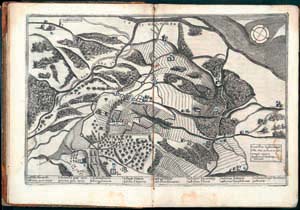
The Catilina mentioned by Prospero was a disgruntled Roman nobleman who lost the consular election in 64 B.C. and then hatched a plot to seize the consulship. Before he could set his plans in motion, the consul (and orator) Cicero denounced the conspirators before the Roman Senate. Catilina fled north to Etruria, where he had allies among the old Etruscan families. Cicero then unleashed the Roman army on Catilina’s ragtag forces.a
Waiting for Cicero’s armies to close in on the Volterra citadel, Prospero, according to Curzio’s scrolls, “despaired of survival”:
I stored away my dear Household Gods and what money I had, together with this treasury … and the Oracles written in Etruscan and Latin letters. But because the Etruscan language has almost disappeared, I have summarized those [Oracles] that are in Etruscan letters … I committed them all to earth, so that they would not fall into the hands of the enemy.
Prospero’s papers, then, fit conveniently into the tradition of Etruscan priestly wisdom, about which the ancient Greeks and Romans had spoken admiringly. The augurs of Etruria even seemed to have had foreknowledge of Christ’s birth, judging from Prospero’s references to the “prophesied King of the Jews.”
This would not have seemed strange to well-educated young men like Curzio Inghirami, who were accustomed to the notion that God had revealed His plan for human salvation in ancient texts. Scholars routinely bolstered theological arguments by referring to Plato, Virgil and Homer, and a number of ancient Greek and Roman writers traced many of Rome’s social institutions and religious beliefs back to the Etruscans.2 In Tuscany, the land of the Etruscans, the idea that ancient Etruria had created all that was civilized in Roman culture was taken as historical fact.
Curzio sent a message to his father, Inghiramo Inghirami, who was staying in Florence with a relative: Cavaliere Giulio, an important official who was soon to become postmaster general of the Grand Duchy of Tuscany. Cavaliere Giulio insisted that a discovery of such consequence must be announced at once to the Grand Duke Ferdinand, whom he then convinced to initiate government-sponsored excavations at Scornello.
In December Curzio assembled his largest expedition yet at Scornello. The workmen soon exposed a course of thick masonry walls, presumably part of what Prospero had called the “Citadel.” Amid the tangled roots of ancient oaks and ilex, they found more bundles. When cracked open, these, too, yielded new paper scrolls in Latin and Etruscan.
One of the documents gave a name to the bundles: “Scarith.” There was also new information about Prospero himself:
Prospero of Fiesole, to the friend who shall discover these: My father … taught me not only the Etruscan, but also the Greek and Hebrew tongues, and later the art of Augury and the secrets of nature herself, who provides all things for man … [Yet] it is not prophecy that compels man, but the Great Aesar, who, when he had created man, created him as the possessor of his own will …
I saw the three stars, Caris, Mor, and Turg in conjunction, and I saw from lightning on the plains of Asgaria, that what all the Scarith contain shall not be found, unless you, your friend, and your father will have been present; know nonetheless, that if you, your friend, and your father [text missing] those stars shall be thrice evil for you.
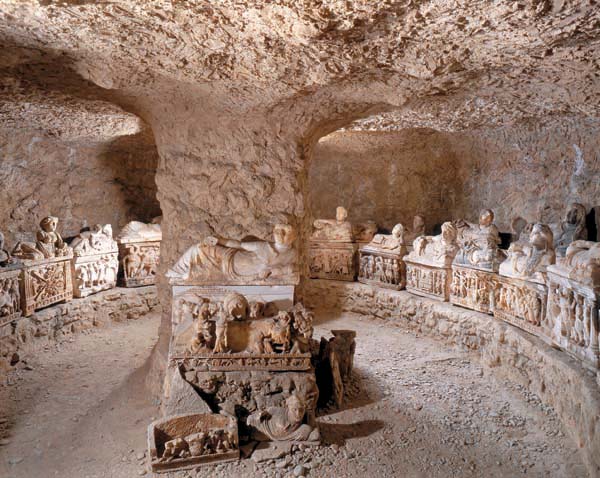
In Curzio’s day, scholars understood only about 20 Etruscan words (“Scarith” was a new addition to this corpus) that were preserved in Greek and Roman literature. One of these words was “Aesar,” which the ancient sources translate as “God.”3 Also, Prospero’s divination from “lightning on the plains of Asgaria”b suggested that thunder-divination was important in Etruscan religion, as the ancient authors note. Latin sources from late antiquity state that Etruscan books on the interpretation of thunder were used in Rome until the sixth century A.D.
In January 1635 Curzio found a Scarith with its outer layer scorched away. Nearby lay a battered tin statue, with the top of its head missing and Etruscan letters inscribed on the hem of its skirt. In that pitiful figurine, Curzio recognized the sole survivor of Prospero’s “dear household gods.” They also found a broken bronze lamp. All of this, it seemed, was evidence of sudden devastation. “We arrived at the conclusion,” Curzio wrote, “That when the Romans captured Scornello, they carried [Prospero] off and then toppled the Citadel to the ground.”
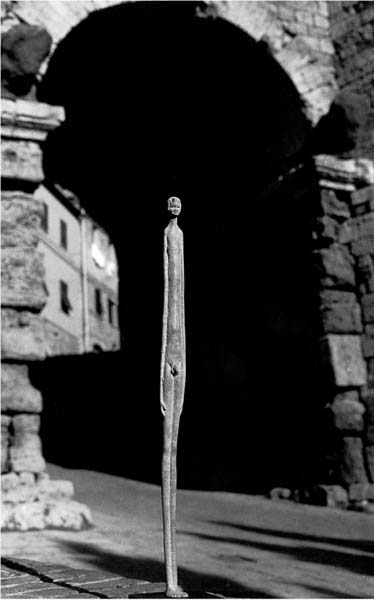
Curzio Inghirami and Father Vadorini then made the fateful decision to turn their treasures over to Volterra’s leading learned academy, the Sepolti (literally “Buried Men,” so-called because their love of knowledge made them “dead” to the busy material world). After examining the Scarith, some—but not all—of the Buried Men had doubts about the authenticity of the documents. These skeptics observed that the ancient sources, such as Livy and Pliny, reported without exception that the Etruscans wrote their books on bolts of linen, not on paper.c
Curzio’s response was swift, elegant and erudite. The paper scrolls of Scornello, he asserted, show that the “linen books” mentioned by the ancients must have been written on paper made of linen rags, like the paper of the 17th century. In the absence of any actual Etruscan cloth books, the Scarith themselves provided the only evidence. Curzio’s argument looked all the more impressive because he provided archaeological as well as literary evidence to back it up.
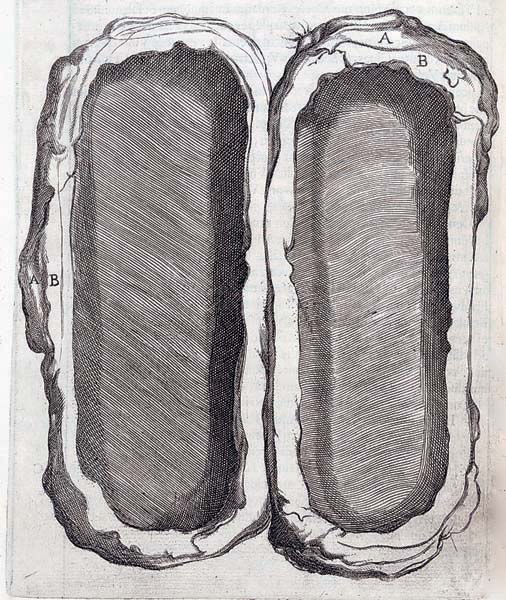
Grand Duke Ferdinand summoned Curzio to Florence for a private showing of the Scarith, followed by public presentations before professors at the universities of Pisa and Florence. Reactions were mixed; some scholars acknowledged the antiquity of the Scarith while others suspected a hoax. The grand duke decided to ask the police to look into the matter.
With the urging of Cavaliere Giulio, Curzio Inghirami committed his “antiquities” to press, in a book on the Etruscan history of Volterra. At a time when books published in Florence used low-grade paper and worn-out typefaces, Curzio’s Ethruscarum Antiquitatum Fragmenta (1636) was crisply printed on folio sheets of good paper. It had two foldout maps, drawn by Father Vadorini, showing Volterra in its Etruscan glory days—a bustling city packed with temples, theaters and obelisks—and the sadly reduced Volterra of 1636. Vadorini also supplied a map of the ancient site at Scornello, showing the foundation walls of Prospero’s bastion laid out across the Volterran hinterland. Many of the Scarith texts were illustrated in both full-page woodcuts and expensive copper-plate engravings. The various casings were also illustrated in cutaway drawings, so that readers who would never have a chance to handle a real Scarith could garner a reasonable idea of what the bundles were like.
The book, in short, was gorgeous and expensive—for a reason. With the authenticity of the Scarith in question at home, Curzio’s Ethruscarum Antiquitatum Fragmenta carried Prospero’s scrolls beyond Tuscany to an international audience. At the same time, and perhaps deliberately, the book deflected the burden of authentication from the physical evidence of the Scarith themselves (the paper) to the texts they contained.
What made Curzio Inghirami’s history extraordinary in its own day was its grounding in archaeology, beginning with Volterra’s Etruscan walls, the most extensive example of Etruscan architecture to survive from antiquity. Several of the ancient gates were still largely intact, including the Porta all’Arco with its three colossal heads peering down as they had for millennia. But no great legends were associated with Volterra’s ruins. Chiusi could boast of the warlord Lars Porsenna, and Rome had her Etruscan kings and queens. And there was Viterbo, whose Etruscan history was apparently discovered toward the end of the 15th century, in the form of ancient writings by a series of authors ranging from Berosus the Chaldean (the Librarian of Babylon) to the Roman poet Propertius, all collected into a composite history by the Dominican friar Giovanni Nanni, who published under the more Etruscan-sounding name of Annius of Viterbo. This work listed entire dynasties of Etruscan heroes for Viterbo and Rome. By the 16th century, however, Nanni-Annius’s masterwork had been exposed as a shameless forgery, but his history was so vivid and persuasive that no one was entirely certain what was true and what was false.
Curzio Inghirami knew that his history of Etruscan Volterra had to be placed in the grand sweep of universal history. He had to include local landmarks and names, ancient scripts and artifacts. He needed to make his own account harmonize with—or better, supplement—the accounts of ancient Greek and Roman authors and, if possible, the Bible.
The latter half of Ethruscarum Antiquitatum Fragmenta is a long list of Etruscan cities with their reigning lords and vassal knights, each distinguished by an insignia. This catalogue shows the influence of medieval chronicles as well as chivalric literature, and like medieval chronicles it is boring, but it serves ts designated purpose. Like Annius of Viterbo, Curzio Inghirami based his text on the inscriptions and coats of arms in Volterra and its environs that survived, sculpted in stone, from earlier eras, and he flattered his neighbors for miles around by providing them with ancestors and a detailed history stretching back to Etruscan times.
By the time the Ethruscarum Antiquitatum Fragmenta appeared in print, however, the authenticity of Curzio Inghirami’s finds was being severely questioned. The University of Pisa’s professor of humane letters, Paganino Gaudenzio, expressed outrage that anyone could take the Scarith seriously. His De Charta: Exercitatio (1636) traced the history of the Latin word charta (writing material) to establish that it could not possibly have meant paper until the medieval era. “I’ll cry out,” he declared, “and again I’ll cry out that the charta of the ancients was made of papyrus.”
Gaudenzio then went after the Scarith themselves, decrying Prospero as a fiction.4 He later teamed up with a Danish scholar, Heinrich Ernst, to ridicule the lore contained in the Scarith, in particular the astronomy:
Who, unless they have their brain in their feet, does not see that all of the things he [Curzio] has collected are ridiculous, made up, twisted? On page 4 of the Fragments he refers to three stars, Caris, Mor, and Turg: What, I ask, are these stars?5
A far more vociferous attack came at the hands of the Greek librarian at the Vatican, Leone Allacci, who in 1640 published his own critique of Curzio’s discovery. Allacci abandoned any pretense of gentlemanly discourse from his very first sentence, which likened the beautiful Ethruscarum Antiquitatum Fragmenta to a pile of manure: a “new Augean stable … full of foul odors and outrage.” Allacci was appalled at what he called the “ridiculous fables,” and he implied strongly that Curzio had created them.6
To this end, Allacci cut to the heart of Prospero’s Latin style, claiming that it would have made Cicero blush—and thus implying that Curzio’s own Latin left a good deal to be desired. Adding insult to injury, Allacci compared the Ethruscarum Antiquitatum Fragmenta to the notorious forgeries of Annius of Viterbo, suggesting that Annius’s work had provided Curzio with his chief model.
Curzio engaged his detractors with treatises of his own, though only one of them was published: his Discourse by Curzio Inghirami About the Objections Made to the Tuscan Antiquities, drafted in 1642 and printed in 1645. (The fact that he wrote it in Italian suggests that Allacci’s assault on his Latin skills had hit home.) This work featured hundreds of pages of learned arguments on paper and Etruscan history. It also contained assessments—ultimately refutations—of all the various arguments that the Scarith were forgeries.
Curzio also noted that the police had never turned up evidence of wrong-doing. He pointed out that he had made the Scarith available for inspection, and many people had taken him up on the offer. And he asked what his motive for such an elaborate scheme could possibly be: “I have no other profit than to have spent hundreds of scudi,” he wrote, “and no other honor than to have found buried antiquities that could have been found in just the same way by some base plowman.”
When Curzio died in 1655, a decade after his vigorous defense of the finds, questions still remained about the authenticity of the Scarith, with the weight of scholarly opinion decidedly tilted toward their being forgeries. The Scarith thus gradually ceased to be objects of much curiosity. Then, in 1700, 45 years after Curzio’s death, it was finally noticed, by a Tuscan artist, that the paper on which the Scarith texts were written bore the watermark of the state paper factory in Colle di Val d’Elsa.
In other words, it was all a hoax—though a hoax of a distinctly Tuscan kind. One of the most time-honored forms of Tuscan humor was (and is) the beffa, the practical joke, and the more far-fetched and extensive the beffa, the better. Judged as a classic Tuscan beffa, the Scarith of Scornello were magnificent: What started as the prank of two giggling teenagers ended up as Europe’s antiquarian sensation, with partisans pro and con scattered from the Baltic coast to Malta. And like so many beffe, once Curzio’s forgeries gained momentum, they charged ahead on their own, out of anyone’s control.
This article is adapted from the author’s book The Scarith of Scornello: A Tale of Renaissance Forgery (Chicago: University of Chicago Press, 2004).
MLA Citation
Footnotes
Volterra’s defeat is one example of the Etruscans’ relentless absorption by Rome after the defeat of the Etruscan ruler Tarquin the Proud in 509 B.C. The last episodes of the struggle were played out in the first century B.C. By the time of the emperor Augustus (27 B.C.–14 A.D.), Etruscan writing had all but disappeared from tombs, buildings, coins, statues and books—from everything except certain religious texts.
The Nordic ring of Asgaria, with its evocations of Thor hammering thunderbolts on the plain of Asgard, also struck a chord. Many in Europe’s most learned circles, beginning with the Swedish Catholic scholar Johannes Magnus in the mid-16th century, had noted the similarity between Scandinavian runes and Etruscan script. Prospero’s texts appeared to support theories suggesting a cultural bridge.
Endnotes
Curzio Inghirami, Ethruscarum Antiquitatum Fragmenta (Florence: Amadore Massi, 1636 [with a false imprint of Frankfurt, 1637]). Much of the material relating to Curzio Inghirami’s words, thoughts and actions comes from this text.
See Giovanni Cipriani, Il mito etrusco nel Rinascimento fiorentino (Florence: Leo S. Olschki, 1980; and Gabriele Morolli, “Vetus Etruria” in Il mito degli Etruschi nella letteratura architettonica nell-arte e nella cultura da Vitruvio a Winckelmann (Florence: Alinea Editrice, 1985).
Massimo Pallottino, Testimonia Linguae Etruscae (Florence: La Nuova Italia, 1969 [2nd ed.]), #803. The word is described in Suetonius’s Life of Augustus, 97.
Paganino Gaudenzio, Paganini Gaudentii in antiquitates quasdam editas sub nomine Prosperi Faesulani Animadversio, BAV. MS Urb. Lat. 1605, c115v.
Heinrich Ernst and Paganino Gaudenzio, Ad antiquitates etruscas quas Volaterrae nuper dederunt observationes, in quibus disquisitionis astronomicae de etruscarum antiquitatum fragmentis auctor quoque notatur (Amsterdam: apud Joannem Janssonium, 1639).

